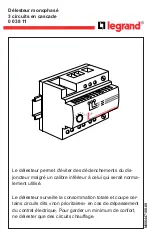
19
The RI-type characteristic is a special character-
istic used mainly in combination with existing
mechanical relays. The characteristic is based on
the following mathematical expression:
t [s] =
where
t = operate time in seconds
k = time multiplier
I = measured phase current
I> = set start current
The graph of the characteristic is shown in
Fig.7.
The RXIDG-type characteristic is a special
characteristic used mainly for earth-fault pro-
tection, where a high degree of selectivity is
needed also for high-resistance faults. With this
characteristic, the protection relay need not to
be directional and the scheme can operate with-
out a pilot communication.
0.339 - 0.236 x
k
I>
I
RI-type
characteristic
RXIDG-type
characteristic
The characteristic is based on the following
mathematical expression:
t [s] = 5.8 - 1.35 x log
e
where
t = operate time in seconds
k = time multiplier
I = measured phase current
I> = set start current
The graph of the characteristic is shown in Fig. 8.
I
k x I>
(
)
If the set start current exceeds 2.5 x I
n
, the
maximum permitted continuous current carry-
ing capacity of the energizing inputs (4 x I
n
)
must be observed.
At inverse time characteristic the effective set-
ting range of the low-set overcurrent stage is
0.5…2.5 x I
n
, although start current settings
within the range 2.5…5.0 x I
n
can be set on the
relay. At inverse time characteristic any start
Note!
current setting above 2.5 x I
n
of the low-set stage
will be regarded as being equal to 2.5 x I
n
.
The operation of the low-set stage based on
inverse time characteristic will be blocked by
starting of the high-set stage. Then the operate
time of the overcurrent or earth-fault unit is
determined by the set operate time of the high-
set stage at heavy fault currents.
















































